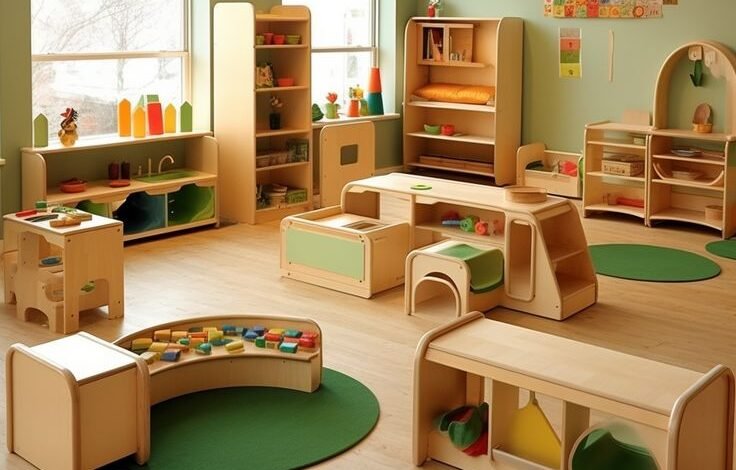
Montessori Furniture: A Guide to Choosing, Setting Up, and the Benefits of Child-Centered Design
The Montessori educational approach, developed by Dr. Maria Montessori over a century ago, is built on the principle that children are naturally curious and capable of self-directed learning. In a Montessori environment, everything is designed to support and empower the child in their learning journey. Montessori furniture is no exception it’s purposefully crafted to align with a child’s developmental needs and foster independence, creativity, and a sense of responsibility. In this blog, we’ll dive into what Montessori furniture is, why it matters, and how it can be incorporated into your home or school setting to create an inspiring learning environment.
What is Montessori Furniture?
Montessori Furniture refers to child-sized pieces crafted to encourage independence, exploration, and hands-on learning. Rather than adhering to the traditional furniture designs that cater to adults, Montessori furniture is made with children in mind—both in function and form. This style of furniture is low to the ground, easy to reach, and often crafted from natural, durable materials. It typically lacks decorative embellishments to avoid distractions and has an aesthetic simplicity that aligns with the Montessori method’s emphasis on practical beauty and order.
In Montessori furniture, each piece serves a specific purpose in the child’s learning experience. For example, a low shelf encourages children to explore materials at eye level and make their own choices, fostering independence. Small tables and chairs enable them to engage in activities comfortably and learn self-care by cleaning up after themselves. Montessori furniture is more than just scaled-down adult furniture; it’s intentionally designed to support a child’s development in every sense.
Key Characteristics of Montessori Furniture
One of the first things you’ll notice about Montessori furniture is its simplicity. The design, often minimalistic, avoids bold colors, patterns, and decorations. Instead, it embraces natural wood tones, clean lines, and organic shapes that promote focus and calmness. Functionality is another essential characteristic each piece has a purpose that aligns with children’s developmental needs.
Child Safety and Adaptibility
Montessori furniture is also built with safety and autonomy in mind. Corners are typically rounded, and furniture is sturdy to avoid tipping. Items are lightweight so that children can move them with ease, which encourages self-reliance and gives them a sense of ownership over their space. Adaptability is key. Because children’s needs evolve quickly as they grow, Montessori furniture is often designed to accommodate these changes. Modular pieces that can be reconfigured and items that serve multiple purposes are commonly found in Montessori settings.
Benefits of Montessori Furniture
Montessori furniture brings many advantages to a child’s learning environment, impacting not only their physical interaction with the space but also their cognitive, emotional, and social development.
Fosters Independence and Confidence
By offering furniture that’s appropriately sized for children, Montessori setups empower kids to take control of their learning experiences. When they can easily access materials, sit at a table without assistance, or select their activities independently, they naturally develop confidence in their abilities. This self-directed engagement is foundational to the Montessori philosophy, which emphasizes the child’s role as an active participant in their education.
Encourages Concentration and Focus
The simplicity and orderliness of Montessori furniture help minimize distractions and foster concentration. Since the furniture and materials are kept within easy reach, children can transition smoothly from one activity to another without disruption. Organized and visually uncluttered spaces promote a calmer, more focused atmosphere, which is essential for young learners’ ability to sustain attention.
Enhances Physical Development
Montessori furniture is designed with ergonomics in mind. From sitting to reaching, each movement is supported in a way that helps children develop fine and gross motor skills. Low tables and shelves encourage natural movements, allowing kids to explore their environment in a way that strengthens their physical coordination. This design also encourages good posture, especially when children are seated on furniture that’s appropriately scaled for their size.
Promotes Responsibility and Respect for the Environment
When children have easy access to their own spaces, it becomes easier for them to learn the value of organization and tidiness. Montessori furniture, through its design and layout, fosters a sense of responsibility by making it simple for kids to clean up after themselves, put materials away, and respect their environment. These habits are invaluable, instilling a sense of order and respect for personal and shared spaces that extends beyond the classroom.
Essential Montessori Furniture for the Home or Classroom
If you’re considering incorporating Montessori furniture into a home or classroom setting, here’s a look at some essential pieces that can transform any space into a child-centered environment. Each of these items supports a specific aspect of learning and development, ensuring that children have everything they need within reach.
Low Shelves
Low shelving is a hallmark of Montessori spaces. These open, child-height shelves allow children to view and select their learning materials independently, which is central to Montessori’s self-directed learning philosophy. In both classrooms and homes, low shelves help children develop decision-making skills and independence as they freely explore materials.
Child-Sized Table and Chairs
A child-sized table and chair set is essential in any Montessori environment. These tables allow children to engage in a variety of activities eating, drawing, reading, and practicing fine motor tasks like puzzles or craftsall at their own comfort level. Unlike high chairs or adult furniture, child-sized tables make it easy for children to sit and move independently, fostering self-sufficiency.
Floor Bed
Montessori floor beds are used in place of cribs, allowing babies and toddlers to move in and out of bed freely, promoting independence from an early age. Floor beds are low to the ground, enabling children to explore their rooms safely without the need for barriers like crib bars. This freedom encourages natural sleep patterns and a sense of security in their surroundings.
Dressing Area with Mirror and Wardrobe
Self-care is a major part of the Montessori philosophy, and a dressing area allows children to practice daily routines on their own. A child-sized wardrobe with accessible clothing racks, drawers, and a low mirror encourages kids to dress themselves, fostering a sense of accomplishment and independence. Placing baskets for shoes or hooks for coats at the child’s height provides easy access to all necessary items, making it simple for them to take part in daily tasks.
5. Work Mats or Rugs
Montessori classrooms often use small work mats or rugs to designate personal spaces for activities. These mats help children define their workspace, teaching them to focus on one task at a time and respect boundaries when working alongside peers. In a home setting, work mats can also provide consistency and routine, giving children a dedicated spot to explore toys and materials while reinforcing habits of organization and respect for personal space.
How to Incorporate Montessori Furniture at Home
Creating a Montessori-inspired environment at home doesn’t require a complete overhaul. Begin by observing your child’s behavior, needs, and interests. Start small by introducing one or two Montessori furniture pieces, such as a low shelf or a child-sized table. Gradually add other elements as needed, always keeping the layout organized, accessible, and minimally cluttered.
Choosing Quality Montessori Furniture
When selecting Montessori furniture, consider factors such as quality, safety, and durability. Because children are naturally curious and active, Montessori furniture should be built to withstand daily use. Look for pieces crafted from sustainable, solid wood, which is durable and non-toxic. Finishes should also be child-safe and free of harmful chemicals.
Be Mindful when Investing
It’s worth investing in reputable brands or craftsmen who specialize in Montessori furniture to ensure that the pieces align with Montessori principles. Furniture should ideally be functional and beautiful, balancing aesthetics with the practical needs of the child.
Conclusion
Montessori furniture is more than just child-sized chairs and tables; it’s a philosophy of creating spaces that support a child’s natural curiosity, independence, and love of learning. By incorporating Montessori principles into your home or classroom, you can create a nurturing environment where children are empowered to explore, grow, and develop in their own unique way.
Whether you’re just beginning to explore Montessori methods or looking to enhance an existing Montessori space, Montessori furniture offers numerous benefits for a child’s development. Through intentional design, simplicity, and accessibility, Montessori furniture from a reputable Montessori store provides a foundation for lifelong learning, helping children build confidence, concentration, and a sense of responsibility.
Incorporating Montessori furniture into a home or educational setting fosters a mindful and supportive environment for young learners, encouraging them to become active participants in their education and their lives.




